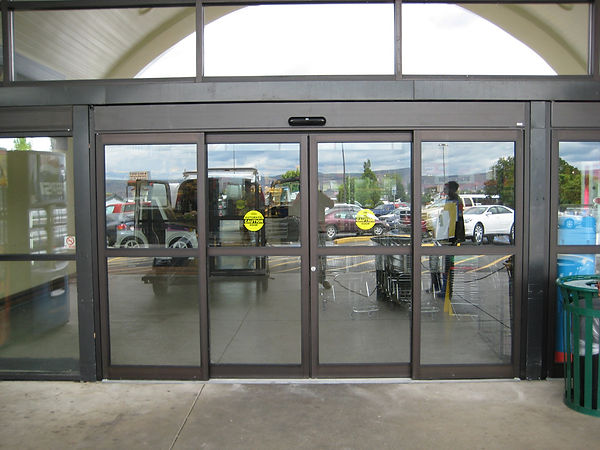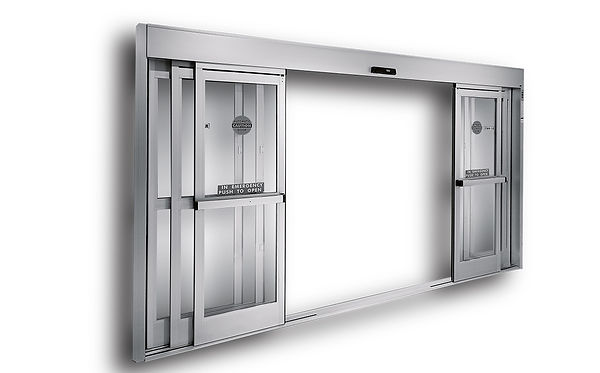
automatic entrance doors
Automatic entrance doors are electric powered and as the name suggests, automatically opens when triggered to allow easier access into a building. They are often coupled with a vestibule and a second pair of doors to prevent drafts and thermal energy transfer. They are most commonly constructed with extruded aluminum stiles and rails which house framing that glazes single, double, or triple pane glass. The finishes available are often very similar to those of aluminum storefront/curtainwall/window framing as anodized: clear, champagne, light bronze, medium bronze, dark bronze, and black among other specialty finishes as well.
Powder-coat PVDF (Polyvinylidene Fluride) coatings (or under one proprietary name as ‘Kynar’) are also utilized though often at a higher cost.
There are a variety of movement options available:
standard sliding


Swinging
Folding


Revolving
Telescoping

Automatic entrance doors are equipped with an operator which powers the doors movement and is commonly housed in a box or chamber often within the top rail or header of the door, but flush mounted operators are available as well. Within the operator typically resides a microprocessor control system and often a digital display as well for diagnostics and adjusting settings. Most standard operators run on a 1/8 horsepower motor and drive the movement of the doors with either a linear drive or more commonly, a neoprene belt drive system.


The most common glazing utilized in modern commercial construction is double pane, insulated, low-E glass. Also the door frame system is typically thermally-broken for resistance to thermal energy transfer. With some models the ‘breakout’ option is available which in emergencies or when moving large items, allows a closed pair of doors to be pushed open (similar to a swinging door system) manually allowing swift egress.
CLosing and opening speeds can be manually adjusted with closing delay times manually input as well. Many modern doors are provided with double astragal weatherstripping seals where the doors come together.

Activation types can consist of:

Automatic sensors (infrared or microwave
Round/square wallmounted push pad/plates



bollard mounted push pads/plates
-keyless digital code entry
-key switch entry
-touchless sensors
or the units can be set to automatic when the operator is down or to give the unit a rest.
In terms of sliding door systems, the most common available widths are 7-16′ with 2, 3, or 4 door panel designs. Single sliding and bi-parting openings options are commonly available. Narrow, medium, wide, and slimline style panels are the options in terms of framing/trim appearance. Common header sizes are 4″ x 6″, 6″ x 6″, or 6″ x 8″.
The Glass entrance door assembly itself can be single or double leafed and often consists of a host of hardware options. At a minimum an aluminum entrance door system will consist of a hinge, lock, stop, electric or hydraulic operator, strike, push & pull bar/plate/handle, threshold, and weatherstripping. Some additional options that are often chosen with an glass entrance doors are panic hardware, kick plates, bumpers, etc. The most common height is 7′ but 9′ tall doors are often available as well, albeit usually at a premium cost. Most building inspection departments have special requirements if an automatic glass entrance/exit door is planned to be an emergency egress door. Glazing is commonly 1/2″ or 3/4″ tempered and can be tinted with gray and bronze being most typical tints. Weatherstripping is commonly installed at the entire perimeter of the door system, thresholds, jambs, and header activating upon proper door closure. The threshold height is typically 1/2″ protrusion maximum for ADA accessibility guidelines.
The following are common framed door types found with automatic aluminum entrance doors:
Narrow Stile – STiles/rail are narrow providing a thin, sleek look higlighting the stiles lightly while drawing attention to the glass and building interior more.
Medium Stile – A moderate rail/stile width.
Wide Stile – The widest stile/rail option available creating a girthy frame look.
Automatic sensors (infrared or microwave
